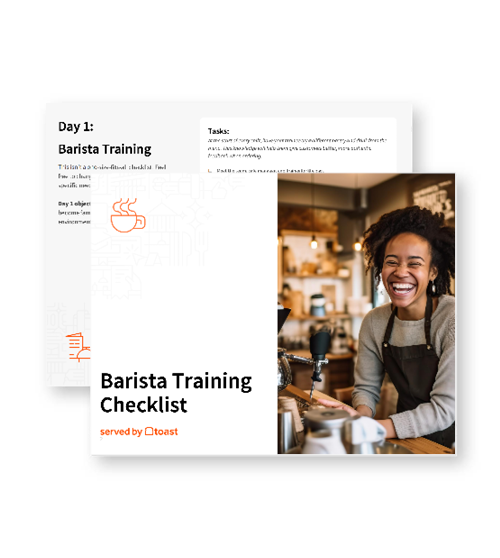
Employment Laws Every Restaurateur Should Understand
Running a restaurant requires a legal education, too. Here are some of the most important laws anyone in the restaurant industry should be familiar with.

Gretchen Van VlymenAuthor


Restaurant Labor Cost Calculator
Unlock the power of data-driven labor management with our free Restaurant Labor Cost Calculator. Stop guessing and start optimizing your staffing decisions today.
Get free downloadThe following is written by Toast's HR Services Team. The HR Services team consults members of the Toast community about HR-related issues affecting their restaurant operations, including general staff management, payroll, compliance, employee conflicts, and other restaurant staffing related issues, questions, and concerns. To learn more about Toast's HR Services team and ways they can help your restaurant thrive, click here.
The following content is for informational purposes only and is not intended as legal, accounting, tax, HR, or other professional advice. You are responsible for your own compliance with laws and regulations. Contact your attorney or other relevant advisor for advice specific to your circumstances.
There are countless compliance and regulatory laws restaurant owners, operators and managers need to be aware of when it comes to waiters and waitresses, but those associated with how their employees are paid - i.e. “wage and hour” laws - are among the most complicated and most frequently violated. This is largely due to the fact that servers commonly have a complex “tipped” rate of pay and are subject to special rights and restrictions which vary largely by city/state and are only found in the restaurant and hospitality industry.
Restaurants have to make sure employees are paid what Federal (Fair Labor Standards Act) and local law stipulates, otherwise they may be faced with steep financial liabilities from a legal complaint filed by a current or previous employee - or worse, a group of employees - otherwise known as a “class action” lawsuit. Further, employees who are not paid correctly are more likely to turnover, resulting in higher recruiting and training costs for ownership, as well as declining sales resulting from a less pleasing dining experience for guests.
Below are some of the biggest mistakes restaurant owners make when it comes to paying waiters and waitresses, and tips for avoiding them.
Restaurant Labor Cost Calculator
Unlock the power of data-driven labor management with our free Restaurant Labor Cost Calculator. Stop guessing and start optimizing your staffing decisions today.

The Restaurant Staffing Laws to Understand and Abide By
1. Laws considering uniforms
If a restaurant requires employees to wear a uniform, it is important to understand the laws regarding the cost of the uniform and who must pay. Per Federal law, employers are not allowed to require employees to pay for uniforms if that purchase brings their wages below minimum wage. Some states don’t allow for uniform deductions at all! Additionally, the Department of Labor (DOL) doesn’t consider tips when determining whether the uniform cost would drop an employee’s wages below minimum wage. For many employees working in a restaurant, their wages are at or below minimum wage and therefore it would not be permissible to charge these employees for a uniform.
To avoid potential wage and hour violations, it is best to provide required uniforms for employees instead of having them buy their own or taking it out of their paycheck. Another option is to require employees to wear a more general outfit, like dark jeans and a generic white shirt, which the DOL doesn’t consider to be a uniform.
2. Laws related to scheduling and breaks
Predictive Scheduling
Predictive Scheduling Laws refer to a new set of regulations that require employers to provide employees with their schedule in advance and pay a certain amount of money to the employee if changes occur too close to their shift start date/time (i.e. “predictability pay”). The goal of these laws is to provide employees with more predictable schedules, and thus predictable income opportunities.
These laws are often hard to comply with as they vary by location and require extremely nimble timekeeping and payroll systems. For example, in San Francisco, employers must provide employees with their schedules at least two weeks in advance and make no changes with less than seven days’ notice. Seattle also requires two weeks’ notice and demands compensation for any changes made after the schedule has been posted.
In theory, predictive scheduling eliminates some of the challenges of on-call scheduling for employers and employees alike, and reinforces habits that help better estimate labor expenses and prepare for busy time periods. However, last minute schedule changes are bound to occur. As a result, employers need to make sure they are abiding by all predictive scheduling laws in their locations and or face significant financial penalties and back-pay.
Restaurant Scheduling Template
Use the Restaurant Scheduling Template to easily schedule your restaurant staff's shifts.

Meal and Break Laws
Many states have instituted meal and break laws that stipulate the amount of breaks, how long they should be, and when employees should take them. For example, in California, if an employee works a shift that is more than five hours, they have to get a meal break that is no less than 30 minutes. Failing to provide this meal break can result in daily penalties for the employer.
Ensuring compliance with meal and break laws is especially challenging in the restaurant industry as it is a fast-paced environment with long hours and demanding customers. Every restaurant should have a written policy that employees are aware of to mitigate any risks of lawsuits. Additionally, restaurants need to make sure managers are trained on these laws, and are actively enforcing them and encouraging employees to take their breaks.
3. Laws outlining tipped hourly wages and overtime pay
Restaurants in certain states are often allowed to pay a “tipped” rate of pay which is less than minimum wage to certain employees whose duties and earnings qualify them to be paid that way. This results in a number of complexities.
First, their employer must make sure that the employees are declaring enough times to earn at least minimum wage per hour, shift or work week (depending on local/state law). If not enough tips are declared/recorded, then the restaurant must make up the difference to ensure they are making at least the minimum wage where they work.
Further, because waiters and waitresses are often paid a “tipped” hourly rate of pay, calculating the correct overtime rate can prove to be a challenge. For example, if a tipped employee is paid using the tip credit, the correct overtime pay is calculated by taking the minimum wage, multiplying it by 1.5 and then subtracting the tip credit, which is the difference between the legal minimum wage and what restaurants are allowed to pay tipped employees. Where restaurants often go wrong is by simply multiplying the tipped employees’ hourly rate by 1.5, which would ultimately result in underpayment of overtime wages.
Another tricky area for calculating overtime is when dealing with a service charge (or auto gratuity), which the DOL defines as any type of fee that is automatically added onto a customer’s bill. Normally, employers do not need to include tips when calculating overtime pay, but service charges are an exception. Employers are required to include the service charge when determining the employee’s regular rate of pay, which will effectively increase the employee’s overtime rate.
4. Laws related to employee classification
Classifying employees correctly as “exempt” or “nonexempt” is crucial for restaurants because these classifications determine who is eligible for overtime pay and who isn’t. When an employee is misclassified, the restaurant is at risk for a lawsuit requiring back wages and damages paid to the employee.
It is a common misconception that as long as you pay someone a salary, then they are not eligible to receive overtime, but just meeting the salary requirement is not enough. That employee also must pass a duties test, which is a measure the DOL uses to determine the scope of an employee’s responsibilities and understand what their role actually entails regardless of their title.
For example, you may give someone the title of Manager on Duty, or Shift Lead, but not actually the responsibility of managing other employees, and therefore they may not meet the requirements to be exempt, even if they are a salaried employee with a title that “sounds like” a manager.
When determining how to classify employees, look at their role and responsibilities holistically. What are their primary duties? Do they occasionally help manage other people, or do they have the ability to hire, discipline and terminate employees? These types of questions will make sure employees are classified correctly and help to avoid potential lawsuits.
5. Laws related to tips and tip pooling
Credit Card Processing Fees
The DOL requires that employees retain all of their tips and one exception to this is credit card processing fees on tips given as part of a credit card transaction. Though permissibility of this practice varies by state, in some cases employers may take a part of the tip to pay for a credit card transaction fee. However, before exercising this right, employers should carefully research local laws to determine legality, confirm that they are taking the correct amount of fees as they tend to differ by credit card company, and ensure that these deductions are not resulting in employees being paid less than minimum wage at the end of the day.
Not all employees can legally participate in tip pooling
Again, the DOL stipulates that tips are solely owned by the waiter or waitress who receives them. However, another exception to this is a valid tip pool or tip sharing arrangement. Employers must be careful with who is included in a tip pool. Ownership, managers and supervisors are never allowed to be included in a tip pool. Only in certain jurisdictions, when the employer is paying full minimum wage (i.e. not the tipped minimum wage), may back of house employees may be included. Otherwise, those folks are off limits as well.
The most common rule of thumb is that if you are not paying the full minimum wage, restaurants need to make sure only people that customarily receive tips and provide direct service to customers are in the tip pool. There are some positions that can toe the line and it is important to remember that roles can be different at different restaurants. For example, if a host only shows customers to their seats and walks away, they shouldn’t be included in the tip pool because they didn’t provide service to the customer beyond seating them. If the host is responsible for checking in on the customer, refilling water, helping bus the table, then they may qualify to be included in the tip pool.
Tip Pooling Calculator
Use the Tip Pooling Calculator to learn how to distribute tips back to your restaurant’s employees using the tip pooling method.

Wage and hour laws are complicated, but you don’t need to be an expert to help mitigate risk at your restaurant. Having a basic understanding of these most common mistakes will help to keep your restaurant compliant and your employees happy.
Related Restaurant Staffing Resources
Is this article helpful?
DISCLAIMER: This information is provided for general informational purposes only, and publication does not constitute an endorsement. Toast does not warrant the accuracy or completeness of any information, text, graphics, links, or other items contained within this content. Toast does not guarantee you will achieve any specific results if you follow any advice herein. It may be advisable for you to consult with a professional such as a lawyer, accountant, or business advisor for advice specific to your situation.
Read More
Subscribe to On the Line
Sign up to get industry intel, advice, tools, and honest takes from real people tackling their restaurants’ greatest challenges.



